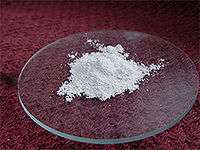Strontium carbonate
 | |
| Names | |
|---|---|
| IUPAC name
Strontium carbonate | |
| Other names | |
| Identifiers | |
| 1633-05-2 | |
| 3D model (Jmol) | Interactive image |
| ChemSpider | 14666 |
| ECHA InfoCard | 100.015.131 |
| EC Number | 216-643-7 |
| PubChem | 15407 |
| RTECS number | WK8305000 |
| UNII | 41YPU4MMCA |
| |
| |
| Properties | |
| SrCO3 | |
| Molar mass | 147.63 g/mol |
| Appearance | White powder |
| Odor | Odorless |
| Density | 3.74 g/cm3 |
| Melting point | 1,494 °C (2,721 °F; 1,767 K) (decomposes) |
| 0.0011 g/100 mL (18 °C) 0.065 g/100 mL (100 °C) | |
| Solubility | soluble in ammonium chloride slightly soluble in ammonia |
| Refractive index (nD) |
1.518 |
| Structure | |
| rhombic | |
| Hazards | |
| Safety data sheet | External MSDS data |
| NFPA 704 | |
| Flash point | Non-flammable |
| Related compounds | |
| Other cations |
Magnesium carbonate Calcium carbonate Barium carbonate |
| Except where otherwise noted, data are given for materials in their standard state (at 25 °C [77 °F], 100 kPa). | |
| | |
| Infobox references | |
Strontium carbonate (SrCO3) is the carbonate salt of strontium that has the appearance of a white or grey powder. It occurs in nature as the mineral strontianite.
Chemical properties
Strontium carbonate is a white, odorless, tasteless powder. Being a carbonate, it is a weak base and therefore is reactive with acids. It is otherwise stable and safe to work with. It is practically insoluble in water (1 part in 100,000). The solubility is increased significantly if the water is saturated with carbon dioxide, to 1 part in 1,000. It is soluble in dilute acids.
Preparation
Other than the natural occurrence as a mineral, strontium carbonate is prepared synthetically in one of two manners. First of which is from naturally occurring celestine also known as strontium sulfate (SrSO4) or by using soluble strontium salts by the reaction in solution with a soluble carbonate salt (usually sodium or ammonium carbonates). For example if sodium carbonate was used in solution with strontium nitrate:
Sr(NO3)2 (aq) + Na2CO3 (aq) → SrCO3 (s) + 2 NaNO3 (aq).
Uses

The most common use is as an inexpensive colorant in fireworks. Strontium and its salts emit a brilliant red color in flame. Unlike other strontium salts, the carbonate salt is generally preferred because of its cost and the fact that it is not hygroscopic. Its ability to neutralize acid is also very helpful in pyrotechnics. Another similar application is in road flares.
Strontium carbonate is used for electronic applications. It is used for manufacturing CTV to absorb electrons resulting from the cathode.
It is used in the preparation of iridescent glass, luminous paints, strontium oxide or strontium salts and in refining sugar and certain drugs.
It is widely used in the ceramics industry as an ingredient in glazes. It acts as a flux and also modifies the color of certain metallic oxides. It has some properties similar to barium carbonate.
It is also used in the manufacturing of strontium ferrites for permanent magnets which are used in Loudspeakers and door magnets.
Strontium carbonate is also used for making some superconductors such as BSCCO and also for electroluminescent materials where it is first calcined into SrO and then mixed with sulphur to make SrS:x where x is typically europium. This is the famous "blue/green" phosphor which is sensitive to frequency and changes from lime green to blue . Other dopants can also be used such as gallium, or yttrium to get a yellow/orange glow instead.
Because of its status as a weak Lewis base, strontium carbonate can be used to produce many different strontium compounds by simple use of the corresponding acid.
Microbial precipitation
The cyanobacteria, Calothrix, Synechococcus and Gloeocapsa, can precipitate strontian calcite in groundwater. The strontium exists as strontianite in solid solution within the host calcite with the strontium content of up to one percent.[1]
References
- ↑ Henry Lutz Ehrlich; Dianne K Newman (2009). Geomicrobiology, Fifth Edition. CRC Press. p. 177.
External links
- Reference page at CeramicMaterials.Info
- International Chemical Safety Card 1695
